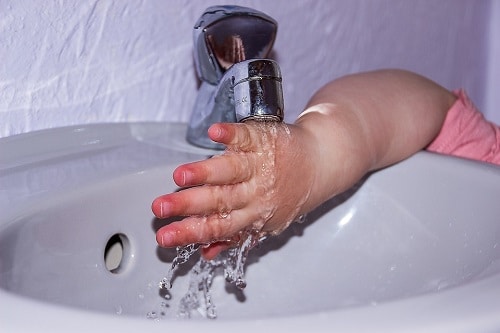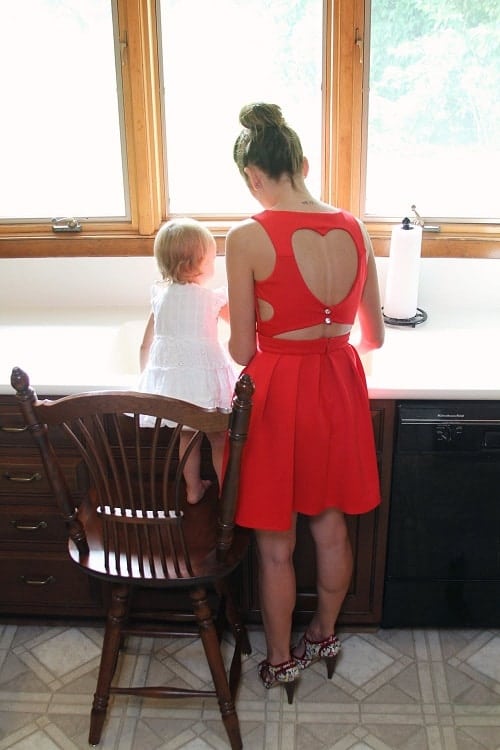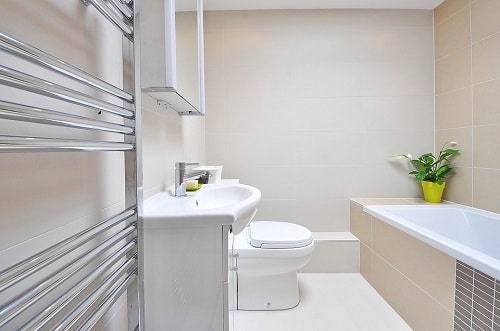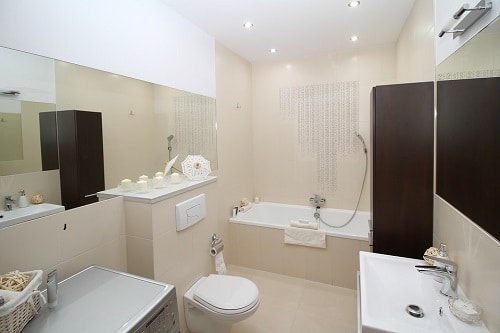
The bathroom. Part of every morning ritual. You probably use it so often that you have become oblivious to how unsafe the bathroom can be for kids.
Don't worry, I have your back. I have created this handy guide to showcase the dangers your bathroom hides and how to keep your baby safe from them.
The following guide will cover general bathroom childproofing. For more detailed information on specific bathroom hazards, refer below:

So without further ado, let us explore how to childproof your bathroom.
So obvious that you may not have thought of it. Is there really anything in the bathroom that you want your child to access without your supervision?
If you answered no to the above question then you should set about securing the door to the bathroom.
Depending on the type of door you will have numerous solutions available. If the bathroom door is a hinged door, then you could try these products and Do-It-Yourself guides.
The most simple solution that suits just about all bathroom doors is a hook-and-eye lock. Mounting the lock well above a child's reach will make unsupervised entry into the bathroom just about impossible.
The end result is simple. If your baby can't enter the bathroom, then your mind will be at ease.
Of course, you should still practice the other baby proofing bathroom methods in this guide. You can easily forget to lock doors while being distracted by the hundred other child-related worries you face. Oh, the joys of being a parent.
You can easily forget to lock doors while being distracted by the hundred other child-related worries you face. Oh, the joys of being a parent.

Of course, there will be times when you need to take your baby into the bathroom. Babies need baths too.
Only ever let your baby in the bathroom when you are around to ensure his or her safety. Try to establish this as a routine.
Never leave your little one alone in the bathroom. If you need to leave to answer the door or answer the phone then take your child with you.
A top-heavy uncoordinated child is not the most sturdy at the best of times. Adding a slippery floor to the mix is just asking for trouble.
A non-slip rubber mat will give your little one that extra traction on the floor after he has just finished soaking it during bath time.
A good bathroom mat will have little suction cups to prevent the mat from sliding across the floor when weight is placed upon it.
I use a non-slip mat both in the bath and on the tiles by the bath. This helps me keep my little one upright while I proceed to dry him off.
Just be sure to dry the underside of the mat every now and then to prevent mold growth.
Unless a pipe bursts in your house, your bathroom will be the room that most water runs through each day. Unfortunately, an abundance of moisture gives ample opportunity for mold to grow and flourish.
If your baby decides that mold would make a tasty treat you risk nursing a sore tummy or worse, fever and vomiting. Inhaling mold and mildew can also lead to respiratory problems in your child.
Because mold prefers dark, out of the way places it can easily be missed by an adult. Your baby, with a viewpoint much closer to the ground, will have a better view of any spots where mold could grow.
Mold can even grow in or on your baby's bath toys.
So how can you avoid exposing your child to mold in the bathroom? Simple. You just have to be mindful of the following:
For further reading on what to do if your child eats mold, check out this guide. The guide refers to food mold but the dangers to your child are the same.
A child can drown in less than an inch of water. Amazing. And scary. very scary.
Small children are curious, top-heavy and uncoordinated. Your baby could easily fall headfirst into the water, become trapped and drown.
After filling a bath or filling the sink, immediately pull the plug. If the water is not there, then it poses no risk to your child.

Appliances are great. I can't live without my blowdryer, I refuse to believe there was a time before it existed.
If your house is anything like mine, plug-in appliances will be a feature in your bathroom, from curling iron to an electric shaver. While they are great for you, they are not so good for your child.
Appliances that are used in the bathroom are either sharp, like electric shavers, or hot, like a curling iron. The first risk they pose is burning or puncturing your little one's skin.
The second risk is far more serious than the above should a plugged-in appliance fall into the water. Electrocution.
When are finished using your blowdryer or preferred appliance, immediately unplug it and put it away
On the topic of electrocution, have you considered installing a GFCI?
A ground-fault circuit interrupter (GFCI) interrupts the flow of electricity, should it come into contact with water, near instantaneously.
GFCI's help prevents electrical shock, burns, and electrocution. Everything a parent dreads happening to their baby.
GFCI's are required in new constructions anywhere that water and electrical outlets will be in close proximity to one another.
If you live in an older house, it is unlikely that you will have GFCI receptacles installed.
If you do choose to install A GFCI, remember to use a licensed contractor. Also ensure that the GFCI is tamper-resistant, to help prevent your child from playing with it, like the one below.
Available Colors: Three
Features:
If you have a man that likes to be clean-shaven, then very likely there will be sharp objects in your bathroom.
Pointy and sharp objects like nail clippers, razors and scissors should all be placed in a locked cabinet.
If you do not have a child safety lock available, bathroom cabinet then use your child's small stature to your advantage. Place the sharp objects well out of reach high up on a window sill or in a linen closet

Are you noticing a pattern? Baby proofing is largely hiding or removing objects that can cause harm.
What is obviously lipstick to you could be a tasty meal for a baby. I always find it funny that they refuse to eat brussels sprouts when they are older but will happily eat many awful tasting things when young.
Like sharp objects, cosmetics and medications should be hidden away. That includes:
Basically, if it can end up in your child's stomach and shouldn't, then it should be hidden away.
While you are busy securing all the other objects in the bathroom from your child, you can easily overlook the trash can.
The trash can in the bathroom can contain all manner of goods that you wouldn't want your child anywhere near. Used razor blades, sanitary napkins and all manner of unsafe garbage are all within easy reach of a child.
Your best bet is to hide the trash can behind lockable doors. Another alternative is to remove the trash can from the bathroom completely and use a single trash can in the house for all garbage.
The priciest option available is to get a childproof trash can. These trash cans have a slide lock to hinder the child from opening them.
The disadvantage is that you will have to remember to lock the trash can every time you use it.
Colors: Black, White & Silver.
Features:
Your child is like a monkey. Children are verity creative in finding objects that can be used as a ladder to reach an out of the way place.
Household objects like washing hampers and bathing chairs can all be used to reach unsafe areas like the sink or high up cupboards.
The easiest way to reduce this climbing temptation is to remover any and all objects that can potentially be used to aid climbing.

Congratulations. You have reached the end of another of my baby proofing guides. Hopefully, you have gleaned useful knowledge to help keep your child safe and sound in the bathroom.
Featured Image Source: Pixabay
Related Resources
Our Purpose